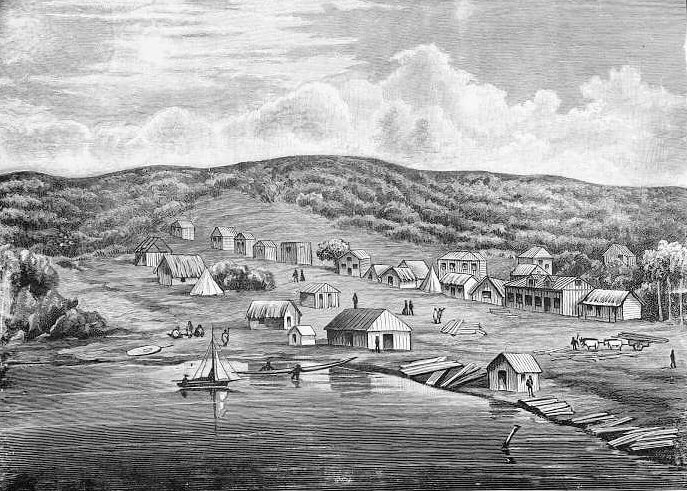
Auckland 1841, year of Louisa’s birth
The claimant for being the first European girl born in Auckland regularly caused controversy but when Louisa Nabbs of Pirongia died in 1911 she was top contender.
It had been a life of firsts for Louisa, whose parents Charles and Harriet Hill arrived in New Zealand from Gloucester, England via Sydney, in the late 1830s. They initially settled at Russell, Bay of Islands, but Māori unrest saw them move to Auckland on St Patrick’s Day, 1841. Charles had the first hotelkeeper’s license in Auckland, which had been established as the colony’s capital the year before, selling liquor from a raupo whare.
That August Louisa was born and Lady Hobson, wife of the first Governor of NZ, aware of the struggles of a new mother in the fledgling town, made personal inquiries at the Hill’s whare regarding the welfare of mother and child.
Louisa was baptised by the Rev Mr Churton in a raupo church, the predecessor of St. Paul’s. Twenty-two years later the same reverend officiated when Louisa married John Daley, of the Third Waikato Militia, at St Mary’s Church, Parnell, in November 1863. John Daley was serving at Pirongia and Louisa journeyed from Auckland to Waikato with him by ship, coming right up the Waikato River. The Waikato War had begun in July that year and the ship’s captain, anxious about being ambushed, ordered the women and children below decks. The expected attack, however, did not happen and the settlers reached their destination safely. Daily life though was overshadowed by the fear of being surprised by Māori warriors.
When Louisa’s first child, James John Daley, was born in 1865 he was the first European boy born within the boundaries of the Pirongia township. But Louisa’s husband soon vanished, rumoured lost at sea, leaving her with two small boys. Louisa then married Sergeant William Nabbs of the 60th King’s Royal Rifles and the Waikato militia. They bought land in Mangapiko and were the first residents in that area.
In 1887, her son James, aged 22, badly shattered his left hand when a gun burst. He became the first surgical patient in the new Hamilton (Waikato) Hospital. His thumb and two fingers were amputated in a candlelit operation. Three months later there was another first at the hospital – Louisa’s husband William became the first patient to die there, aged 62. He suffered from an internal disease, incurable except for necessary surgical instruments, which could not be procured in New Zealand, but which Dr Kenny had on order from England.
Louisa, who suffered from rheumatism for many years, died aged 70, at Pirongia. The debate over who was the first European child born in Auckland flared up periodically in newspapers. In 1915 a correspondent signing themselves ‘Facts’ asserted that a Mrs Slator was born on March 11, 1841, trumping everyone, and could produce documentary evidence of the fact. But no evidence was ever produced, and it seems that Louisa – although not the first European child born in Auckland (that was a boy) – was the first girl.









